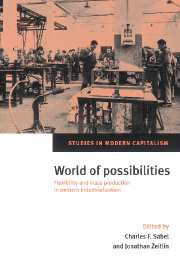Book contents
- Frontmatter
- Contents
- List of contributors
- Acknowledgments
- Stories, strategies, structures: rethinking historical alternatives to mass production
- Part I The modernity of tradition
- Part II The battle of the systems
- 5 Between flexibility and mass production: strategic ambiguity and selective adaptation in the British engineering industry, 1830–1914
- 6 The lost paradigm: an Italian metalworking empire between competing models of production, 1900–1920
- 7 “Have a heart for the manufacturers!”: production, distribution and the decline of American textile manufacturing
- 8 The small-holder economy in Denmark: the exception as variation
- Part III The resurgence of flexible production
- Index
7 - “Have a heart for the manufacturers!”: production, distribution and the decline of American textile manufacturing
Published online by Cambridge University Press: 12 December 2009
- Frontmatter
- Contents
- List of contributors
- Acknowledgments
- Stories, strategies, structures: rethinking historical alternatives to mass production
- Part I The modernity of tradition
- Part II The battle of the systems
- 5 Between flexibility and mass production: strategic ambiguity and selective adaptation in the British engineering industry, 1830–1914
- 6 The lost paradigm: an Italian metalworking empire between competing models of production, 1900–1920
- 7 “Have a heart for the manufacturers!”: production, distribution and the decline of American textile manufacturing
- 8 The small-holder economy in Denmark: the exception as variation
- Part III The resurgence of flexible production
- Index
Summary
In standard chronicles of American industrialization, the textile industry appears in two roles during widely separated epochs. In the early republic, c. 1790–1840, it serves as vehicle for discussion of technology transfer and the rise of the factory system. Samuel Slater's Rhode Island alliance with the Almy and Brown merchant house brings mechanized spinning to the new United States, setting the stage for Francis Lowell's copying of British power looms, the establishment of integrated, capital-intensive production at Waltham, Massachusetts, and with the addition of Paul Moody's inventiveness plus the marketing connections of Boston investors, the elaboration of staple cotton goods production at the falls of the Merrimack River. The political dimension of the account involves Alexander Hamilton's promotion of national economic independence through state policies fostering manufacturing, the stimulus that Jefferson's embargo and the War of 1812 provided to textile entrepreneurs, the protection tariff of 1816 which favored domestic cotton goods, widespread ruin in the late 1810s as foreign goods flooded markets, and the politics of incorporation (as legislative acts had to be passed to charter each of the first generation corporate enterprises). The faltering steps of early promoters and politicians lead toward an heroic climax in the erection of the Lowell System, a comprehensive net of interlocked corporations controlling water power, machinery building and fabric construction by the 1830s. Technologically and organizationally sophisticated for their time, the Lowell mills set out a template for others to adopt/adapt as the railroad phase of industrialization opened.
- Type
- Chapter
- Information
- World of PossibilitiesFlexibility and Mass Production in Western Industrialization, pp. 310 - 343Publisher: Cambridge University PressPrint publication year: 1997
- 1
- Cited by



